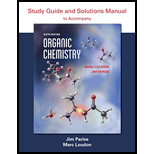
Organic Chemistry Study Guide and Solutions
6th Edition
ISBN: 9781936221868
Author: Marc Loudon, Jim Parise
Publisher: W. H. Freeman
expand_more
expand_more
format_list_bulleted
Question
Chapter 17, Problem 17.57AP
Interpretation Introduction
Interpretation:
The structure of compound
Concept introduction:
Allyl bromides are formed when
Expert Solution & Answer
Want to see the full answer?
Check out a sample textbook solution
Students have asked these similar questions
Don't use ai to answer I will report you answer
Consider a solution of 0.00304 moles of 4-nitrobenzoic acid (pKa = 3.442) dissolved in 25 mL water and titrated with 0.0991 M NaOH. Calculate the pH at the equivalence point
What is the name of the following compound?
SiMe3
Chapter 17 Solutions
Organic Chemistry Study Guide and Solutions
Ch. 17 - Prob. 17.1PCh. 17 - Prob. 17.2PCh. 17 - Prob. 17.3PCh. 17 - Prob. 17.4PCh. 17 - Prob. 17.5PCh. 17 - Prob. 17.6PCh. 17 - Prob. 17.7PCh. 17 - Prob. 17.8PCh. 17 - Prob. 17.9PCh. 17 - Prob. 17.10P
Ch. 17 - Prob. 17.11PCh. 17 - Prob. 17.12PCh. 17 - Prob. 17.13PCh. 17 - Prob. 17.14PCh. 17 - Prob. 17.15PCh. 17 - Prob. 17.16PCh. 17 - Prob. 17.17PCh. 17 - Prob. 17.18PCh. 17 - Prob. 17.19PCh. 17 - Prob. 17.20PCh. 17 - Prob. 17.21PCh. 17 - Prob. 17.22APCh. 17 - Prob. 17.23APCh. 17 - Prob. 17.24APCh. 17 - Prob. 17.25APCh. 17 - Prob. 17.26APCh. 17 - Prob. 17.27APCh. 17 - Prob. 17.28APCh. 17 - Prob. 17.29APCh. 17 - Prob. 17.30APCh. 17 - Prob. 17.31APCh. 17 - Prob. 17.32APCh. 17 - Prob. 17.33APCh. 17 - Prob. 17.35APCh. 17 - Prob. 17.36APCh. 17 - Prob. 17.37APCh. 17 - Prob. 17.38APCh. 17 - Prob. 17.39APCh. 17 - Prob. 17.40APCh. 17 - Prob. 17.41APCh. 17 - Prob. 17.42APCh. 17 - Prob. 17.43APCh. 17 - Prob. 17.44APCh. 17 - Prob. 17.45APCh. 17 - Prob. 17.46APCh. 17 - Prob. 17.47APCh. 17 - Prob. 17.48APCh. 17 - Prob. 17.49APCh. 17 - Prob. 17.50APCh. 17 - Prob. 17.51APCh. 17 - Prob. 17.52APCh. 17 - Prob. 17.53APCh. 17 - Prob. 17.54APCh. 17 - Prob. 17.55APCh. 17 - Prob. 17.56APCh. 17 - Prob. 17.57APCh. 17 - Prob. 17.58APCh. 17 - Prob. 17.59AP
Knowledge Booster
Similar questions
- K Draw the starting structure that would lead to the major product shown under the provided conditions. Drawing 1. NaNH2 2. PhCH2Br 4 57°F Sunny Q Searcharrow_forward7 Draw the starting alkyl bromide that would produce this alkyne under these conditions. F Drawing 1. NaNH2, A 2. H3O+ £ 4 Temps to rise Tomorrow Q Search H2arrow_forward7 Comment on the general features of the predicted (extremely simplified) ¹H- NMR spectrum of lycopene that is provided below. 00 6 57 PPM 3 2 1 0arrow_forward
arrow_back_ios
SEE MORE QUESTIONS
arrow_forward_ios
Recommended textbooks for you
 Organic ChemistryChemistryISBN:9781305580350Author:William H. Brown, Brent L. Iverson, Eric Anslyn, Christopher S. FootePublisher:Cengage Learning
Organic ChemistryChemistryISBN:9781305580350Author:William H. Brown, Brent L. Iverson, Eric Anslyn, Christopher S. FootePublisher:Cengage Learning Organic Chemistry: A Guided InquiryChemistryISBN:9780618974122Author:Andrei StraumanisPublisher:Cengage Learning
Organic Chemistry: A Guided InquiryChemistryISBN:9780618974122Author:Andrei StraumanisPublisher:Cengage Learning

Organic Chemistry
Chemistry
ISBN:9781305580350
Author:William H. Brown, Brent L. Iverson, Eric Anslyn, Christopher S. Foote
Publisher:Cengage Learning

Organic Chemistry: A Guided Inquiry
Chemistry
ISBN:9780618974122
Author:Andrei Straumanis
Publisher:Cengage Learning